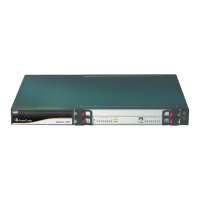Version 7.0 385 Mediant 3000
User's Manual 20. Coders and Profiles
Coder Name Packetization Time
(msec)
Rate (kbps) Payload
Type
Silence
Suppression
EVRC-B (4GV)
[EvrcB]
20 (default), 40, 60, 80,
100, 120
[0] Variable
(default)
[1] 1/8
[2] 1/4
[3] 1/2
[4] Full
Dynamic N/A
iLBC
[iLBC]
20 (default), 40, 60, 80,
100, 120
15 (default) Dynamic
(default 65)
[0] Disable
[1] Enable
30 (default), 60, 90, 120 13
MS RTA (NB)
[ms_rta]
20 (default), 40, 60, 80 11800 115 N/A
MS RTA (WB)
[ms_rta_wb]
20 29000 114 N/A
Speex NB
[speex_nb]
20 2.15 (default);
5.95; 8; 11; 15;
18.2; 24.6; 3.95
78 N/A
Speex WB
[speex_wb]
20 3.95 (default);
5.75; 7.75; 9.8;
12.8; 16.8; 20.6;
23.8; 27.8; 34.2;
42.2
78 N/A
T.38
[t38fax]
N/A N/A N/A N/A
T.38 Version 3
[t38fax]
- - - -
T.38 Over RTP N/A N/A Dynamic
(default 106)
N/A
20.2 Configuring Coder Groups
The Coder Group Settings table lets you configure up to 11 Coder Groups. A Coder Group
is a set of configured coders (coder type, packetization time, rate, payload type, and
silence suppression). Each Coder Group can include up to 10 coders.
The first coder in the Coder Group has the highest priority and is used by the device
whenever possible. If the remote side cannot use the first coder, the device attempts to use
the next coder in the Coder Group, and so on.
To define coders for specific calls, you can configure a Coder Group with the necessary
coders and then assign the Coder Group to the calls using Tel Profiles (see Configuring Tel
Profiles on page 388) or IP Profiles (see ''Configuring IP Profiles'' on page 391).
You can also use Coder Groups for audio coder transcoding of SBC calls. If two SIP
entities need to communicate, but one does not support a coder required by the other, the
device can add the required coder to the SDP offer. The added coder is referred to as an
extension coder. For more information on extension coders, see Coder Transcoding on
page 562.
To apply a Coder Group for transcoding to a SIP entity:

